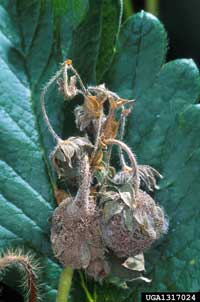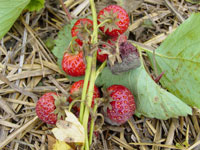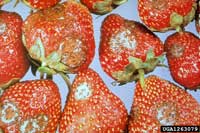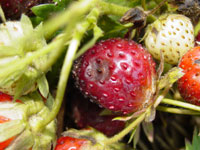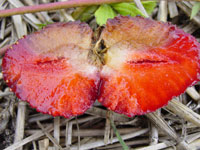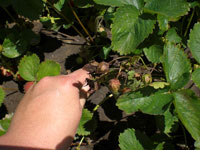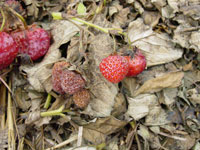Extension > Garden > Diagnose a problem > What's wrong with my plant? > Fruit > Strawberry > Completely black or brown flowers
Strawberries >Flower Bud/Flower > Completely black or brown flowers
1 of 3
Gray Mold
Botrytis cinerea
- Fruit develops indistinct, soft, light brown spots that rapidly enlarge and have a mild rotten smell
- Gray powdery spores form on infected fruit under moist conditions
- Disease favored by wet conditions and temperatures between 41-86F
- One or several flowers in a cluster may turn brown to black and dry out
- Black discoloration may extend down into the flower stalk
- More information on Gray Mold
2 of 3
Anthracnose
Colletotrichum sp.
- Fruit will develop distinct round sunken brown to black blotches with no smell
- Wet pinkish orange sticky spores may form in the center of the fruit infection when wet
- Fruit rot can occur on green or ripe fruit
- Spots on leaves are small (<1/4"), round, sunken and gray-black, often resembling ink spots
- Flower infection results in dried out and brown flowers and flower stalks
- Occurs more frequently in very warm and humid weather (>80°F)
- Plant only healthy, symptom-free plants
- Avoid the use of overhead irrigation and use drip irrigation or a soaker hose
- Remove infected berries from the planting during harvest to reduce spread of the disease to developing fruit
- More information on Anthracnose
3 of 3
Leather Rot
Phytopthora cactorum
- A section of the berry or the entire fruit may turn tan, purple or brown
- Infected berries have a foul “chemical” odor and become tough, leathery
- Berries with any amount of infection are very bitter tasting
- Infects flowers, green fruit and ripe fruit
- Commonly occurs in low areas or where free standing water is present
- Use straw mulch to keep berries from contacting soil and puddled water
- Water through drip irrigation or a soaker hose
- Pick fruit frequently and remove over ripe and diseased berries from the field
- More information on Leather Rot



